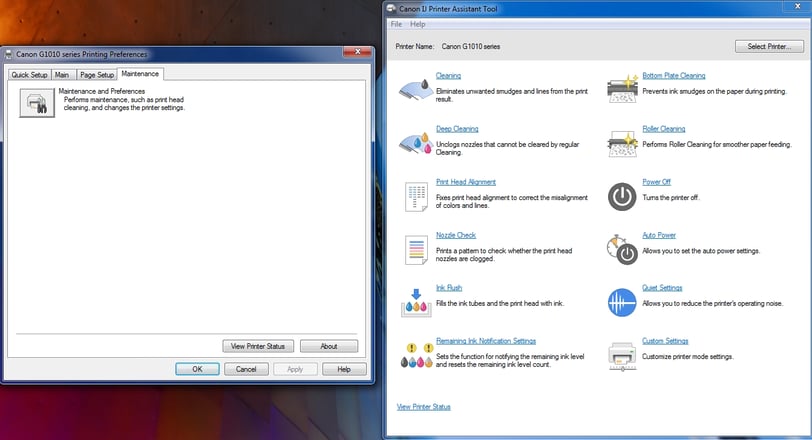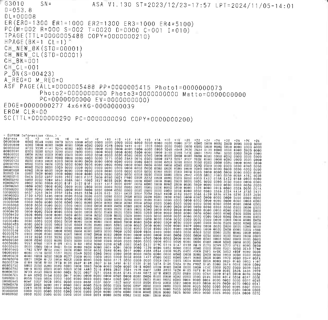Canon Inkjet Printer Maintenance Menu and Internal Page
Canon Inkjet Printer Maintenance Menu and learn how to use internal pages for optimal printer performance. Discover essential features like cleaning, print head alignment, and more to maintain your Canon printer effectively.
Praveen Kumar - Canon Printer Specialist
12/25/20246 min read


What is Canon Printer Maintenance Menu
The Canon Printer Maintenance Menu is a built-in software interface offering various tools to help users maintain and troubleshoot their Canon printers. It provides essential options such as cleaning, print head alignment, and nozzle checks to ensure high print quality. Additionally, the menu allows users to configure printer settings, including ink flush, roller cleaning, and adjusting power settings. Regular use of the Maintenance Menu ensures that your Canon printer operates efficiently, improves print quality, and extends its lifespan. Accessing and utilizing these tools can prevent common issues and keep your printer in optimal working condition.
Cleaning
The Cleaning function helps improve print quality by clearing ink blockages in the print head. It’s an essential feature to use when experiencing faint prints or color inconsistencies. To perform cleaning, simply access the maintenance menu and follow the on-screen instructions. It typically involves running a cleaning cycle that flushes the print head with ink to remove any clogs.
Deep Cleaning
Deep Cleaning is a more thorough version of the regular cleaning function. It’s typically used when regular cleaning doesn’t resolve print quality issues like ink smears or color misalignment. This process uses a higher volume of ink and more intensive cleaning to clear stubborn blockages from the print head. It can take a little longer to complete, but it’s effective for restoring print quality in severe cases.
Print Head Alignment
Print Head Alignment ensures that the print head is correctly aligned to produce sharp and clear text and images. Misaligned print heads can cause blurred or jagged lines or overlapping text. This function typically involves printing an alignment pattern and adjusting the settings to correct any misalignments, improving the overall quality of prints.
Nozzle Check
A Nozzle Check is used to identify any clogged nozzles in the print head. By printing a pattern that checks the ink flow, this function helps detect areas where ink is not being ejected properly. If any issues are found, users can run the cleaning cycle to fix them. It’s a quick and easy way to assess the health of your printer’s ink nozzles.
Ink Flush
An Ink Flush is a more intensive process than regular cleaning and is used to remove dried ink from the print head. This function can help restore print quality if you haven’t been using the printer for an extended period or if you notice a significant drop in print quality. The ink flush removes excess ink residue, ensuring smoother printing.
Remaining Ink Notification Settings
The Remaining Ink Notification Settings allow users to set up alerts when the ink levels are low. This is useful for preventing printer interruptions during critical print jobs. By configuring these notifications, users can plan for ink cartridge replacements ahead of time and avoid unexpected print errors.
Bottom Plate Cleaning
Bottom Plate Cleaning is a specialized feature used to clean the underside of the print head and surrounding areas where ink can build up. Ink residues on the bottom plate can cause streaks or blotches on printed pages. Regular bottom plate cleaning helps maintain clean print output and prevents print quality degradation.
Roller Cleaning
Roller Cleaning is essential for keeping the paper feed rollers free of dust, ink, or paper residue, which can cause paper jams or misfeeds. By running the roller cleaning function, users can maintain smooth paper handling, which is crucial for long-term printer reliability and consistent print quality.
Power Off
The Power Off option is used to turn off the printer when not in use. Turning off your printer properly ensures that it shuts down in a safe state, which can prolong the printer’s lifespan and prevent any unnecessary ink wastage. Some Canon printers may also perform maintenance tasks like print head cleaning during the power off cycle to keep the printer in top condition.
Auto Power
The Auto Power setting allows the printer to automatically turn on or off based on its usage. For example, it can automatically power on when a print job is sent or power off after a certain period of inactivity. This feature helps conserve energy and ensures the printer is ready when needed.
Quiet Settings
Quiet Settings are designed to reduce the noise produced by the printer during operation. Activating this mode reduces the printer’s speed and noise level, making it a good choice for environments where quiet operation is required, such as home offices or late-night printing.
Custom Settings
Custom Settings allow users to fine-tune specific printer preferences, such as paper size, print quality, and energy-saving options. These personalized settings ensure that the printer operates according to your needs, whether you’re printing high-quality documents or saving ink and energy.
View Printer Status
The View Printer Status option provides a real-time overview of your printer’s condition. It shows important information such as ink levels, paper status, print queue, and any potential issues like paper jams or errors. Monitoring this status regularly helps ensure that you are always aware of the printer's health and can take action to resolve issues before they impact performance.


Understand the Purpose of a Nozzle Check
If you notice lines on printed text or photos, or if the text looks cut off, it’s time to do a nozzle check. A nozzle check helps assess the printer’s print quality. The test print usually shows 4-5 striped patterns. If any lines are missing or broken in these patterns, it indicates a potential issue with the print head.
Access the Printer's Maintenance Menu
To begin the Nozzle Check process, follow these steps:
For Windows:
Open the Control Panel and go to Devices and Printers.
Right-click on your Canon printer and select Printing Preferences or Properties.
Navigate to the Maintenance tab.
For Mac:
Open System Settings and select Printers & Scanners.
Choose your Canon printer from the list.
Click on Options & Supplies, then go to the Utility tab.
Run the Nozzle Check
Once in the Maintenance tab (Windows) or Utility tab (Mac), look for the Nozzle Check option.
Select Nozzle Check and click OK or Run. The printer will then print a special pattern of lines to test the nozzle operation.
Evaluate the Nozzle Check Page
The nozzle check page will display several lines of black and color patterns. Here’s how to interpret the results:
Normal Print: If all the lines are clear, without gaps or missing parts, your nozzles are working correctly.
Clogged Nozzles: If there are missing lines, gaps, or unevenness in the print patterns, some of the nozzles are likely clogged.
Clean the Print Head (If Needed)
If your nozzle check page reveals clogged nozzles:
Go back to the Maintenance menu and choose the Cleaning option to clean the print head.
After cleaning, perform another nozzle check to see if the issue is resolved. If not, you may need to run a Deep Cleaning cycle.


Understanding Printer EEPROM Data
The printer's EEPROM (Electrically Erasable Programmable Read-Only Memory) display shown here reveals detailed internal diagnostics typically reserved for technical specialists. This comprehensive report serves as a window into the printer's core operations, storing vital information about its settings, operational status, and historical error records. Understanding this data is essential for proper printer maintenance and troubleshooting.
What is Printer EEPROM Data?
EEPROM is a type of memory in printers that stores critical information about the device’s operations, including error codes, print counts, ink levels, and network configurations. This data helps technicians troubleshoot and repair printers efficiently. Accessing this data is usually done via a service mode or special diagnostic software.
Key Sections of the Report
Printer Model and Serial Details
The header also includes the printer model (for example, MG6200, G3000), serial number, firmware version, and the printer's start time and current time. These details help identify the specific unit and software in use.Error Codes
Error logs such as "ER=1600 ER1=5800" document any problems encountered by the printer. These codes guide technicians in diagnosing problems such as paper jams, carriage jams, print head malfunctions, or sensor errors.Ink and Print Head Information
Entries such as "INK CLR=01" and "CH=001" provide details about the status of the ink cartridge and the print head configuration. The no keeps increasing after you change a cartridge or print head.Page Count and Usage Data
Fields like "ASF PAGE" and "FR PAGE" record the number of pages printed or processed by the printer. These figures are essential for maintenance planning or assessing wear and tear, Information such as how many prints the user has taken and from where is very important.Network Information
Wireless and wired networking details, such as "WL-LAN" MAC addresses, help identify connectivity setups or diagnose network-related issues.Hexadecimal Memory Dump
The bulk of the page consists of a hex dump, displaying raw memory data. While cryptic to most users, this section is invaluable for specialists analyzing detailed configurations or debugging hardware issues.Power on/off Counter
It is also important to know how many times the printer has been turned on and off.
Why is This Important?
EEPROM data serves as a vital tool for maintaining and repairing printers. It allows technicians to:
Pinpoint specific errors without guesswork.
Assess the printer's usage history and health.
Identify software or hardware anomalies.
Conclusion
Although this type of report is technical, it highlights the importance of proper diagnostics in printer maintenance. For users experiencing persistent issues, consulting a technician who can interpret EEPROM data ensures accurate troubleshooting and helps extend the life of the device.
If you’d like to learn more about printer diagnostics or maintenance, feel free to explore additional guides on BestPrinterShop.com!
Get in touch
Reach out for printer advice, tips, and blog inquiries.
Insights
Explore the latest in printer technology and tips.
Resources
Support
contact@bestprintershop.com
+918920029543
© 2024 BestPrinterShop . All rights reserved.
